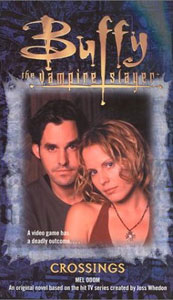After a few late-Season 5 novels skimmed over Joyce’s death as if scared to address it, Mel Odom does it right with the young-adult novel “Crossings” (June 2002). Set between “Forever” (5.17) and “Intervention” (5.18), as most of these late-Season 5 entries are, it digs into the new Buffy-Dawn dynamic while also serving as a sneak preview for additional Season 6 themes like Willow’s magic addiction.
It also rehashes an old idea, but in a fun way. Xander is one of several victims of a powerful demon named Dredfahl who has a rather clever scheme: He tricks the gamers and comic-book geeks of Sunnydale into believing they are beta-testing a virtual reality game where their avatars are demons. In actually, they take over the bodies of demons on a war-torn hellscape dimension, while the demons take over their bodies on Earth.
The fake-out VR is a great concept, although Xander is a bit calm about being trapped in a demon’s body in a hell dimension, and it’s frustrating that his whole time there is spent trying to convince his fellow gamers that this isn’t a game. It might’ve been neat to go into his thoughts about body-swapping with a demon a bit more; Odom leaves some good humor on the table.
Body-swapping was, of course, a central theme of “Who Are You” (4.16) and “A New Man” (4.12), so I also would’ve liked more of Buffy’s and Giles’ reflections on being in someone else’s body. But we only get one brief thought from Buffy on page 144:
The thought of demons inhabiting the bodies of humans disgusted her. Not out of any xenophobic reaction, but out of a sense of claustrophobia. She remembered being trapped in Faith’s body while Faith had paraded around in her body not too long ago. A person’s body was supposed to be their own.
With “Crossings,” we get a good sense of how Odom is expanding Sunnydale to suit his own interests. As with “Unnatural Selection,” he introduces the idea that Xander has many acquaintances from the arcades and comic-book shops – locations not seen on the TV show. And as with “Revenant,” the author sets a lot of the action in the warehouses of Docktown, an area only sparsely shown on TV.
At the same time, the book is grounded in what the characters are going through at this time. I had thought “Sweet Sixteen” might be the first strong Dawn novel, since she’s on the cover, but it’s actually this one. “Sweet Sixteen” shunts Dawn to the side, and Dark Horse’s illustrated novel “Creatures of Habit” has her as a troublemaking teen who sneaks out of the house. But “Crossings” shows that Dawn wants to help, even if only with research, because otherwise she can only focus on her fear of losing Buffy.
Frankly, it’s a little frustrating how it takes Buffy all of Season 6 to realize Dawn can (and should) be a helper. In this book, Dawn of course gets in serious danger while going solo to prove herself. While that is indefensibly reckless, it’s also clear that Buffy doesn’t grasp that her friends are also Dawn’s friends. Along those lines, I love how we learn that Xander used to take Dawn with him to the arcades and comic shops in a big-brotherly way. As Dawn thinks on page 174:

How could Buffy even think I could just go home with Xander missing?
It’s interesting that Giles suggests to Buffy that she not try to be a mother to Dawn, but he doesn’t have good advice for what she should be to Dawn. This time period is tricky to get into because one would think the state of California would step in and check on Dawn’s guardianship situation after Joyce dies. The fact that the TV writers totally skim over the reality of the situation in turn makes it difficult for the tie-in fiction writers.
Odom gets some comedy out of Anya trying to console the girlfriend of a gamer-turned-demon, and some bravado out of Spike. He also introduces two decent characters of his own. A medium named Derek has a successful TV show, but in a flipped script from what we’d expect in the real world, he truly can communicate with ghosts (and dimension-hopping demons, which is more troublesome to him). And a Louisiana man named Bobby Lee Tooker is from a family that has been battling Dredfahl for generations. Both characters widen the mythology in a natural way.
If a person was for some reason only reading the tie-in fiction and not watching the TV show, “Crossings” would be an essential read for how it defines the Buffy-Dawn relationship at this time. A less generous critique of the book is that it reiterates the themes of Season 6 (which had recently wrapped on TV), and is therefore inessential. Just the fact that it’s the first really good Dawn-centric novel, though, makes “Crossings” a winner.
Click here for an index of all of John’s “Buffy” and “Angel” reviews.

